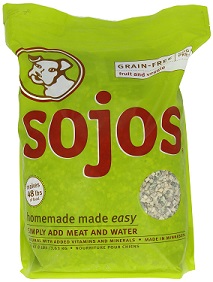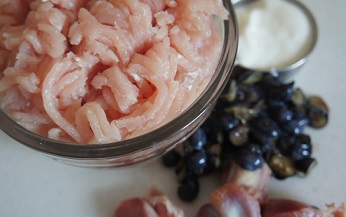Raw dog food diet options
If you feed your dog a raw diet, how do you go about it? Do you feed the pre-prepared frozen patties? Do you buy pre-made mixes and add your own ingredients? Or do you make raw dog food at home?
When someone is first switching her dog to a raw diet, all the options can seem overwhelming. In this post, I’ll go over a few of them (there’s no correct choice), but I’d like to hear what the rest of you do. If someone is new to raw feeding, it really helps to hear from others who have been there.
Option #1 – Pre-made raw dog food in frozen patties
Obviously the most convenient choice. Just open the bag, take out a patty or two and serve frozen or thawed.
I feed about 24 ounces of raw dog food per day to my 70-pound dog. There are lots of great brands out there such as Balanced Blends (a sponsor of my blog).
Commercial raw dog food is typically based off the idea that dogs need fruits and veggies in their diets in addition to raw meat, organs and bones. This is often referred to as the BARF diet, or “Bones And Raw Food.” A nice thing about commercial raw is the bones are ground up with the meat.
When you feed your dog a commercial raw diet, you can feel comfortable he’s getting all the nutrients he needs. Yet, some will say all the added fruits, veggies and minerals may not be necessary, especially if you believe dogs are carnivores.
In addition to the frozen variety, many raw dog food companies offer a freeze-dried option. This is more expensive, but easier to store. It’s also convenient for feeding a dog raw food while traveling.
Pros of commercial raw dog food: Convenient, easy to prepare, balanced, lots of varieties and brands, bones are ground so there’s no reason to worry about your dog choking
Cons to commercial raw dog food: Cost. At $7 or more per pound, it’s just way too expensive for most people. If you can swing it, go for it. If not, keep reading.
Option #2 – Pre-made mixes where you add fresh ingredients
 This is a nice option because you are combining commercial raw dog food with making the food yourself.
This is a nice option because you are combining commercial raw dog food with making the food yourself.
A company called Sojos makes dog food mixes where all you have to do is add water and raw meat. This is a convenient way to feed your dog a raw diet because it takes away a lot of the stress involved with preparation. You don’t have to worry about whether or not your dog is getting the right nutrients. The mixes are made with ingredients such as sweet potatoes, broccoli, dried kelp and dried alfalfa. Add some water and your dog’s raw meat of choice. Done.
And if you’re comfortable mixing your own fruits and veggies but not the meat, Primal makes a product called “Primal Grinds” which include ground meat, organs and bone. You would then add in your own fruits and veggies or whatever else you want to include in your dog’s diet. This is a nice option for people who are uncomfortable feeding their dogs whole bones, and it’s also a way to make sure your dog is getting enough organ meat and calcium.
Pros: Gives you more flexibility and control over what your dog eats. It’s easy to feed a variety of different foods. It helps you transition to a fully homemade raw dog food diet if you’d like.
Cons: Cost is still high. Food preparation is a little more complicated.
Option #3 – Homemade raw dog food

Almost looks kind of good, doesn’t it? This is one of the “meals” I prepared for my dog – ground turkey, chopped blueberries, chicken gizzards and some plain yogurt.
Making your dog’s raw food yourself is usually the most affordable, but it’s also the most complicated. There is more stress involved because you have to plan ahead, store all the ingredients and so on. When I feed my dog a homemade diet, I find it’s easiest if I rotate between four or five different raw dog food recipes so I don’t have to put too much thought into what I’m feeding. If you’re interested in making your dog’s raw food yourself, you should definitely check out my ebook, which includes 10 raw dog food recipes.
Pros: You can save a lot of money this way, but you have to look for sales. Your dog could potentially get more variety. You have more control over what types of bones to feed, whether or not to feed fruits and veggies, whether or not to feed ground meat, etc.
Cons: More work on your part, and lots of dog owners worry their dogs aren’t getting enough nutrients.
How do you know which option is best?
There’s not really a correct way to feed raw. I actually prefer to feed my dog a variety of raw meals, some pre-prepared and some homemade, plus some dry dog food a few times per week. Since he doesn’t get an upset tummy from switching foods, this works for us and I’m able to save money that way.
If you’re a little nervous about feeding your dog raw, I recommend you start out by making it easy on yourself. Buy a bag or two of pre-made frozen patties. Yes, it’s expensive, but it will take some stress away while you get used to the idea of feeding raw. See how your dog does.
If all goes well, consider feeding your dog some homemade raw meals a few times per week. Start out with something cheap and simple like chicken quarters. You don’t have to feed anything fancy at first or worry that every single meal is balanced. With time, you’ll learn that feeding a dog raw food is not that complicated.
Do you feed your dog raw food? Do you make it yourself, or do you buy pre-made raw dog food?

Rebekah
Friday 14th of December 2018
I have a butterball turkey, can I feed my 3 month old German shepherd this?
Lindsay Stordahl
Friday 14th of December 2018
Yes, if it's just regular turkey (not injected with sodium, etc). Im not sure if the butterball brand has anything special or if butterball is just the name.
Judy Spring
Monday 22nd of May 2017
I need recipes for my dog with kidney issues. I've been ordering commercial raw and adding veggies, sweet potatoes or brown rice. I don't know if this is right! There is so much contradictory info out there that I'm about ready to give up. So many say do not give raw and dry dog food.
Chris Fowler
Sunday 17th of November 2013
Great ideas, very interesting reading all the ways people feed their dogs. For myself, I have come a long way from the old days of buying the cheapest bag I could afford to where I am today, mulling over ingredients, protein analysis, and meat vs carbs, etc. I finally decided to go with dehydrated raw from The Honest Kitchen. I liked the company ethos, and they offer a good variety. They also provide some of the charts that Sean was wanting on their website. I have 4 dogs of my own to feed, as well as the dogs I board (they all come with their own food). In the end, I am paying about the same as the high quality kibble used to cost. However, I usually add what ever I have lying around to their meals as well, an egg or two, leftover salad, or meat. I try to vary their diet as much as possible, it just makes sense to me. My dogs have always been chow hounds, food is gone in seconds! what I find interesting is how many dogs I care for who are picky, or have anemic appetites. These dogs usually come with the same kibble, time after time, no variety, and come with strict instructions to have no treats, and no other food. It just makes ya wonder... Thanks again, as always great discussion.
Lindsay Stordahl
Sunday 17th of November 2013
Interesting points about the dry food. I used to feed my dog the same old dry food every single day too. Now, even when I feed dry food I like to mix up the brand and protein source. I know some dogs have sensitive tummies and you have to be more careful. One thing I noticed after switching my dog to raw is that his system seems to have an easier time dealing with variety now.
Rebekah
Saturday 16th of November 2013
I feed homemade raw. I feel it is easier to correctly balance (meat, bones, organs) with bigger dogs than with smaller dogs. I use Sojo's on occasion, but only my two boys will eat it. I also very occasionally buy premade raw, to get a bit of variety into their diet, such as bison.
Lindsay Stordahl
Sunday 17th of November 2013
That's a great point. The commercial raw can add some extra variety.
Andrea (Rocco's House)
Friday 15th of November 2013
I laugh in the face of the $7 per pound bags of frozen food, and feed them cheerfully because they cost NO WHERE NEAR what the vet bills cost me before feeding it. Leia was in the vet every month or so for a $200 bill. That on top of the fact that I was already feeding $90 a bag dog food makes $7 per pound laughably cheap.
That being said I'm now experimenting with home cooked raw, but I'm pretty sure I'll be going back to commercial once my mix of raw meats have been used up. I just can't stomach the smell or texture of raw liver, and neither can my dogs! >.<
I hope you'll consider joining us for NaNoWriMo, we love your blog and are looking for a few more writers to take a turn telling our story. If we don't get more writers soon, we won't be able to finish! Will you join us?
Lindsay Stordahl
Saturday 16th of November 2013
Good point about the vet bills. I can relate to that a bit as far as my dog getting allergies, itchy skin, skin infections, ear infections, etc., while on dry food.